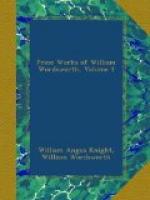40. Rural Architecture. [XIII.]
These structures, as every one knows, are common among our hills, being built by shepherds, as conspicuous marks, and occasionally by boys in sport. It was written at Town-End, in 1801.
41. Foot-note: Great How (l. 4).
Great How is a single and conspicuous hill, which rises towards the foot of Thirlmere, on the western side of the beautiful dale of Legberthwaite.
42. *_The Pet Lamb: a Pastoral_. [XIV.]
Town-End, 1800. Barbara Lewthwaite, now living at Ambleside (1843), though much changed as to beauty, was one of two most lovely sisters. Almost the first words my poor brother John said, when he visited us for the first time at Grasmere, were, ’Were those two angels that I have just seen?’ and from his description I have no doubt they were those two sisters. The mother died in childbed; and one of our neighbours, at Grasmere, told me that the loveliest sight she had ever seen was that mother as she lay in her coffin with her [dead] babe in her arm. I mention this to notice what I cannot but think a salutary custom, once universal in these vales: every attendant on a funeral made it a duty to look at the corpse in the coffin before the lid was closed, which was never done (nor I believe is now) till a minute or two before the corpse was removed. Barbara Lewthwaite was not, in fact, the child whom I had seen and overheard as engaged in the poem. I chose the name for reasons implied in the above, and will here add a caution against the use of names of living persons. Within a few months after the publication of this poem, I was much surprised, and more hurt, to find it in a child’s school-book, which, having been compiled by Lindley Murray, had come into use at Grasmere school, where Barbara was a pupil. And, alas, I had the mortification of hearing that she was very vain of being thus distinguished; and in after life she used to say that she remembered the incident, and what I said to her upon the occasion.




